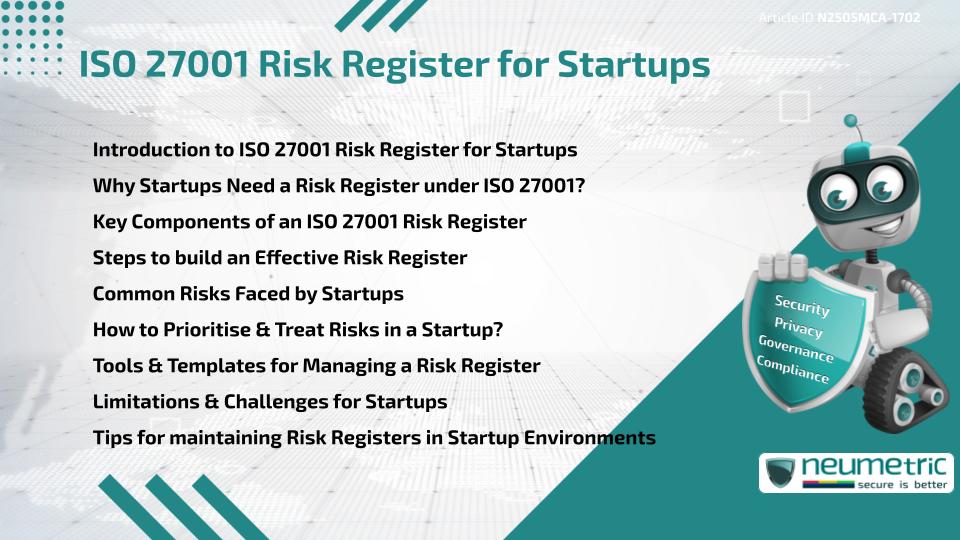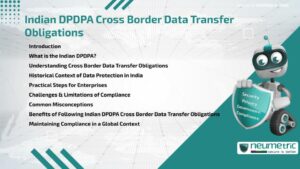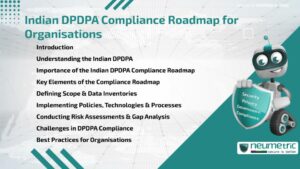Table of Contents
ToggleIntroduction to ISO 27001 Risk Register for Startups
For startups operating in digital-first environments, managing security Risks is no longer optional. The ISO 27001 Risk register for startups is a foundational tool that helps identify, assess & control Information Security Risks. It is a document that lists the Potential Threats which can affect the confidentiality, integrity & availability of your data.
WIth the help of Risk register an organisation can reduce the chance of significant data Threats, improve its ISO 27001 Compliance & gain trust of its customers. Startups often have lean teams & tight budgets, but documenting Risks does not have to be complex.
Why Startups Need a Risk Register under ISO 27001?
Startups move fast. That pace often leads to gaps in documentation or overlooked Risks. The ISO 27001 Risk register for startups offers a systematic way to manage those Risks.
It helps:
- Prove due diligence to investors or clients.
- Meet mandatory Audit requirements.
- Build an effective Information Security Management System [ISMS].
Without this register, startups may be unaware of Threats until a breach occurs. More importantly, ISO 27001 requires Risk Assessment & Treatment plans as part of Clause 6—making the register not just helpful, but necessary.
Key Components of an ISO 27001 Risk Register
A practical ISO 27001 risk register for startups must contain the following essential elements:
- Asset – The resource at Risk (e.g. Customer Data, source code).
- Threat – The possible cause of harm (e.g. hacking, insider Threat).
- Vulnerability – The weakness or shortcoming that allows a Threat to exploit & affect the asset.
- Impact – The result, if the Risk materialises.
- Likelihood – The probability of the Threat occurring.
- Risk Rating – Typically derived by assessing both impact & likelihood together.
- Treatment Plan – The selected approach to address or manage the identified Risk.
- Owner – The team or person responsible for the Risk.
Steps to build an Effective Risk Register
Following steps can guide a startup on how successfully create & effectively maintain a Risk register:
- Identify information assets – Start with digital assets, Third Party services & Intellectual Property.
- List possible Threats & Vulnerabilities – Brainstorm internal & external Risks.
- Assess the Risks – Score the impact & likelihood using a simple matrix.
- Decide how to treat each Risk – Avoid, transfer, mitigate or accept.
- Assign responsibilities – Make sure each Risk has a clear owner.
- Review regularly – Risks evolve, so revisit the register at least quarterly or after major changes.
For lean teams, even simple spreadsheets can be used in the beginning.
Common Risks Faced by Startups
Startups share a set of predictable Risks that the ISO 27001 Risk register for startups must address. These include:
- Weak Access Controls due to rapid team scaling.
- Lack of regular patching on software or platforms.
- Third Party Risks from integrated services or contractors.
- Phishing attacks targeting new Employees.
- Insufficient data backups & Disaster Recovery plans.
Startups should also include human error & accidental data loss as part of their Risk list.
How to Prioritise & Treat Risks in a Startup?
Not all Risks need immediate action. The ISO 27001 Risk register for startups should help prioritise based on impact & likelihood. A simple Risk matrix—such as high, medium & low—makes decision-making easier.
Risk treatment options include:
- Avoidance – Stop using a risky service.
- Mitigation – Apply controls like encryption or firewalls.
- Transfer – Use insurance or contracts to shift Risk.
- Acceptance – Document it & justify inaction.
It is good for an organisation to keep records of the reasons for choosing a particular treatment action as it helps them during Audits & shows their responsible oversight.
Tools & Templates for Managing a Risk Register
The following alternatives can be used by startups in place of sophisticated tools at first:
- Microsoft Excel or Google Sheets – For easily adaptable & team-friendly registers.
- Notion or Airtable – For dynamic, collaborative tracking.
- Free Risk register templates – Available on platforms like Smartsheet or ProjectManager.
Using these tools helps save time while still meeting ISO 27001 documentation needs.
Limitations & Challenges for Startups
While essential, maintaining an ISO 27001 Risk register for startups is not without hurdles:
- Time constraints – Startups may deprioritise documentation.
- Changing environments – Risk factors can evolve quickly.
- Lack of expertise – Teams might not have prior experience with security standards or practices.
- Over-documentation – Trying to capture everything may lead to clutter.
To counter these, keep the register lean & focus only on high-impact areas initially.
Tips for maintaining Risk Registers in Startup Environments
To make the ISO 27001 Risk register for startups effective long term:
- Start small & expand gradually.
- Use templates that are easy to adapt.
- Assign a Risk owner even if it is the founder initially.
- Link it to business goals like funding or Client onboarding.
- Conduct brief monthly Reviews rather than waiting for quarterly Audits.
These simple practices ensure Risk Management becomes part of the culture, not just a checklist.
Conclusion
The ISO 27001 Risk register for startups serves as a core part of any serious Security posture. Using a Risk register not only reassures Stakeholders but it also helps in identifying & treating Threats early as well as aligning with ISO requirements. While startups face unique challenges in documentation, starting with a lean but structured Risk register is achievable & highly effective.
Takeaways
- A Risk register must be used by an organisation if it is aiming for ISO 27001 compliance.
- Startups should focus on real, high-impact Risks.
- Spreadsheets & Notion help early-stage startups manage risks.
- Regular reviews keep the register relevant.
- Simplicity is key—avoid making it overly complex.
FAQ
What is the purpose of an ISO 27001 Risk register for startups?
It helps identify, assess & manage Information Security Risks in a structured, documented way to meet ISO 27001 requirements.
How often should a startup update its ISO 27001 Risk register?
Ideally every quarter or after any major changes in systems, team structure or processes.
Can a spreadsheet be used as an ISO 27001 Risk register for startups?
Yes, many startups begin with simple tools like Excel or Google Sheets to track & update Risks.
What types of Risks should be included in the register?
Include technical, human, process & Third Party Risks—basically anything that could impact Data Security or operations.
Who usually handles the ISO 27001 Risk register in a startup?
In most cases, the responsibility falls to the founder, CTO or the person handling IT or compliance tasks, at least until a formal role is established.
Is a Risk register necessary for achieving ISO 27001 certification?
Yes, it is a required component under Clause 6 of the standard & is reviewed during audits.
What is a Risk treatment plan?
It outlines how a startup plans to address or manage each Risk—whether by mitigation, avoidance, transfer or acceptance.
Is it okay to skip low-priority Risks?
Yes, but each one should still be documented with justification if no action is being taken.
How does a Risk register help during Audits?
It provides evidence of systematic Risk Management & shows that Security is being actively monitored & maintained.
Need help?
Neumetric provides organisations the necessary help to achieve their Cybersecurity, Compliance, Governance, Privacy, Certifications & Pentesting goals.
Organisations & Businesses, specifically those which provide SaaS & AI Solutions, usually need a Cybersecurity Partner for meeting & maintaining the ongoing Security & Privacy needs & requirements of their Clients & Customers.
SOC 2, ISO 27001, ISO 42001, NIST, HIPAA, HECVAT, EU GDPR are some of the Frameworks that are served by Fusion – a centralised, automated, AI-enabled SaaS Solution created & managed by Neumetric.
Reach out to us!





